Contents
- I. Introduction to Cat Behavior
- II. Understanding Your Cat’s Natural Instincts
- III. Reasons Why Your Cat Grabs Your Hand and Bites You
- IV. How to Recognize the Difference Between Playful Biting and Aggressive Biting
- V. Tips for Preventing Hand Biting Behavior in Cats
- VI. Frequently Asked Questions about Cats’ Hand Biting Behavior
- 1. Why does my cat bite my hand when I pet her?
- 2. Is hand biting a form of aggression in cats?
- 3. How can I prevent my cat from biting my hand?
- 4. Are there any medical reasons for hand biting behavior in cats?
- 5. Can hand biting be a sign of fear or anxiety in cats?
- 6. How should I react when my cat bites my hand?
- 7. Can hand biting be a result of insufficient play or exercise?
- 8. Should I seek professional help if my cat’s hand biting behavior persists?
- I. Introduction to Cat Behavior
- II. Understanding Your Cat’s Natural Instincts
- III. Reasons Why Your Cat Grabs Your Hand and Bites You
I. Introduction to Cat Behavior
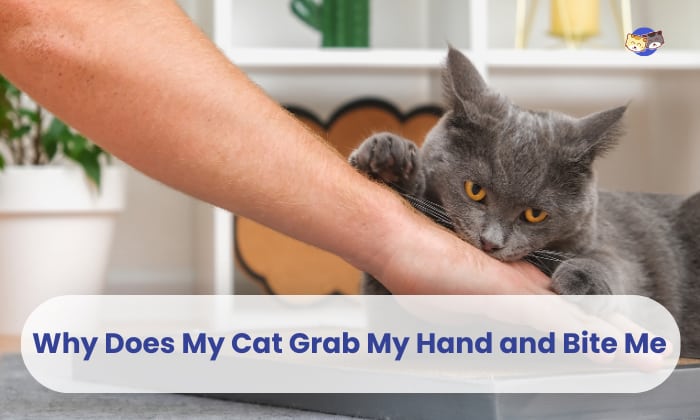
Cats are fascinating creatures with complex behaviors. Understanding their behavior can help us create a stronger bond with our feline friends. From the way they communicate to their unique hunting instincts, cat behavior can sometimes be puzzling. In this article, we will explore some common behaviors, including why your cat grabs your hand and bites you.
1. Communication through Body Language
Cats are known for their expressive body language. They use various signals to convey their feelings and intentions. When a cat grabs your hand and bites you, it may be trying to communicate something important. It could be expressing affection, playfulness, or even a sign of annoyance. Understanding their body language can help us interpret their behavior better and respond accordingly.
2. Playful Nature and Hunting Instincts
Cats are natural hunters. Even domesticated cats retain their instinct to stalk, pounce, and bite. When your cat grabs your hand and bites you during playtime, it may be mimicking its hunting instincts. It sees your hand as a moving target and reacts instinctively. Providing appropriate toys and interactive play sessions can redirect this behavior towards more suitable objects, sparing your hands from accidental bites.
3. Overstimulation and Boundaries
Sometimes, cats can become overstimulated during petting sessions. When a cat reaches its threshold, it may grab your hand and bite as a way to communicate that it has had enough. Understanding your cat’s boundaries is crucial to avoid triggering this response. Watch for signs of discomfort, such as tail twitching or ears flattening, and respect their need for personal space.
4. Redirecting the Behavior
If your cat frequently grabs your hand and bites, it’s important to redirect this behavior. One way to do this is by providing appropriate outlets for their hunting instincts. Interactive toys, scratching posts, and puzzle feeders can engage their natural instincts and keep them mentally stimulated. Additionally, positive reinforcement training can help teach your cat alternative behaviors and reward them for appropriate play.
5. Seeking Veterinary Advice
In some cases, repeated hand grabbing and biting may indicate an underlying issue, such as pain or aggression. If your cat’s behavior becomes aggressive or unmanageable, it’s advisable to seek professional help from a veterinarian or animal behaviorist. They can assess your cat’s behavior and provide guidance on how to address the issue effectively.
II. Understanding Your Cat’s Natural Instincts
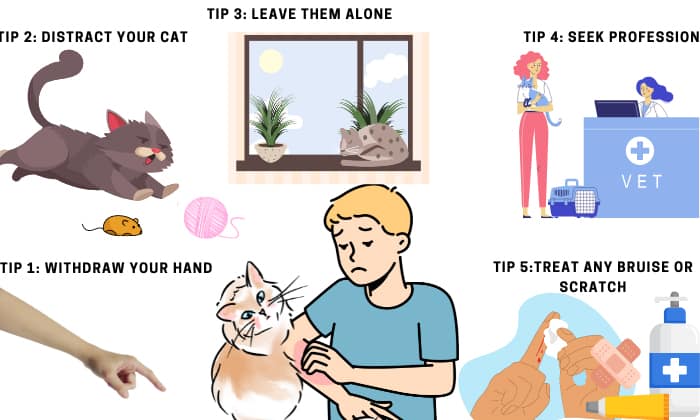
When it comes to understanding why your cat grabs your hand and bites you, it’s important to delve into their natural instincts. Cats are fascinating creatures with unique behaviors that stem from their evolutionary history. By understanding these natural instincts, you can gain insight into why your furry friend engages in certain behaviors.
The Hunting Instinct
One of the most prominent instincts in cats is their hunting instinct. Cats are natural predators and have an innate drive to stalk, chase, and capture prey. While domesticated cats may not need to hunt for survival, this instinct remains strong. When your cat grabs your hand, it could be an expression of their hunting instinct. They see your hand as a moving target and feel compelled to pounce on it.
Playfulness and Socialization
Cats are known for their playful nature. Playtime offers them mental and physical stimulation, helping them release excess energy. There are times when your cat may grab your hand and bite during playtime. This behavior is a way for them to engage with you, imitating the play-fighting they experience with their feline companions. It’s their way of bonding and expressing their affection.
Communication and Boundaries
Cats also use grabbing and biting as a form of communication and setting boundaries. It’s their way of letting you know what they want or don’t want. For example, if your cat grabs your hand and bites gently, it could be a sign that they want attention or affection. On the other hand, if the bite is more forceful or accompanied by growling, it’s a clear indication that they are feeling threatened or irritated and want you to back off.
Redirecting Energy and Stress
Cats can sometimes grab your hand and bite as a means of redirecting their energy or coping with stress. If they are feeling anxious or overwhelmed, they may resort to this behavior as a way to release tension. In these instances, it’s important to provide alternative outlets for their energy, such as interactive toys or scratching posts, to prevent them from using your hand as a target.
Understanding your cat’s natural instincts is crucial in deciphering their behaviors. By recognizing their hunting instinct, playfulness, communication methods, and coping mechanisms, you can create a harmonious and enriching environment for your feline companion. Remember, patience and positive reinforcement are key to addressing any unwanted biting behaviors and fostering a strong bond with your beloved pet.
III. Reasons Why Your Cat Grabs Your Hand and Bites You
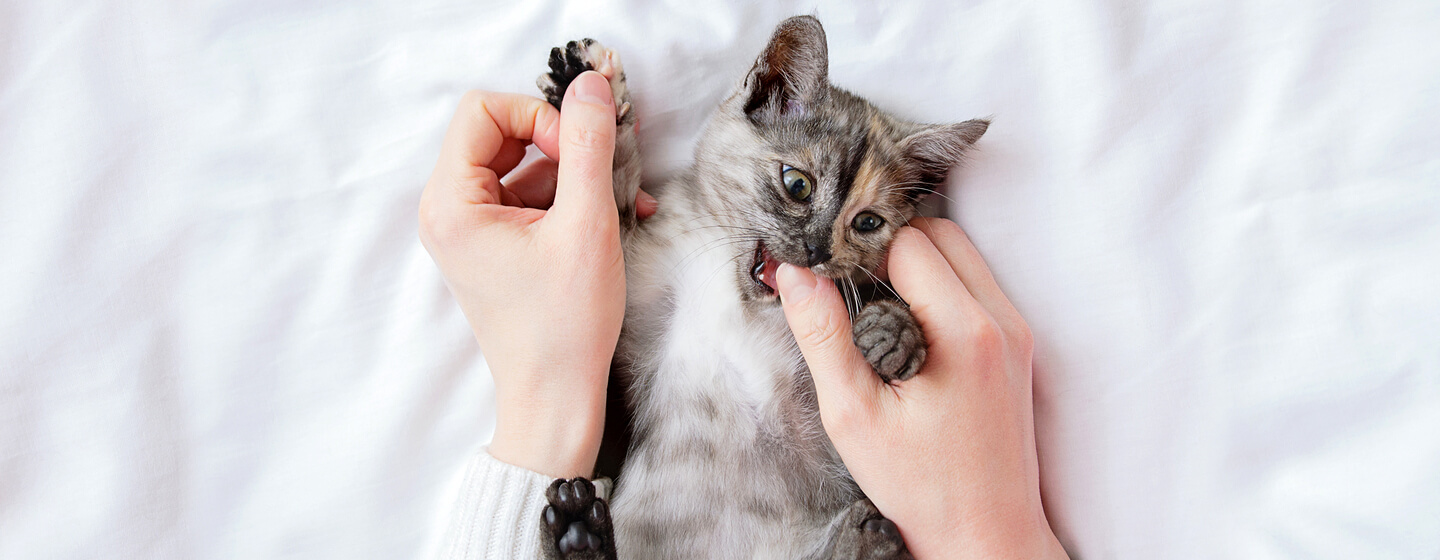
Having a cat can be a delightful experience, but sometimes their behavior can leave us scratching our heads. One common issue that cat owners face is when their feline friend grabs their hand and bites them. This behavior can be both confusing and painful, but there are several reasons why your cat might be exhibiting this behavior.
1. Playful Nature
Cats are natural hunters, and their instincts often drive them to engage in playful behavior. When your cat grabs your hand and bites you, it might be their way of expressing their playful nature. They might see your hand as a toy and simply be trying to engage in some interactive play. However, they may not realize that their playful bites can be painful to humans.
2. Attention-Seeking Behavior
Cats are also known for their love of attention. When your cat grabs your hand and bites you, it could be their way of seeking attention from you. They might have learned that biting elicits a response from you, even if that response is negative. It’s important to remember that cats crave interaction and might resort to biting if they feel neglected or want your attention.
3. Overstimulation
Cats have a threshold for stimulation, and when that threshold is crossed, they might react by biting or scratching. If you’re petting your cat and they suddenly grab your hand and bite you, it could be a sign that they are overstimulated. Pay attention to your cat’s body language and signs of discomfort, such as twitching tail or flattened ears, to avoid reaching this point.
4. Fear or Aggression
In some cases, your cat might grab your hand and bite you out of fear or aggression. This behavior can occur if your cat feels threatened or cornered. It’s important to recognize the signs of fear or aggression in your cat’s body language, such as hissing, growling, or dilated pupils. If your cat consistently displays this behavior, it might be helpful to consult with a professional animal behaviorist.
5. Teething or Dental Issues
Just like humans, cats go through teething phases, and during this time, they might feel the need to bite and chew more. If your cat is young, their biting behavior could be a result of teething. Additionally, dental issues such as gum inflammation or toothache can cause your cat to grab your hand and bite you. Regular dental check-ups and providing appropriate chew toys can help alleviate this behavior.
Understanding why your cat grabs your hand and bites you can help you address the behavior and find appropriate solutions. Remember to always approach your cat with patience and understanding, and seek professional help if needed. With time and proper training, you can help your cat develop healthier ways to play and interact with you.
IV. How to Recognize the Difference Between Playful Biting and Aggressive Biting
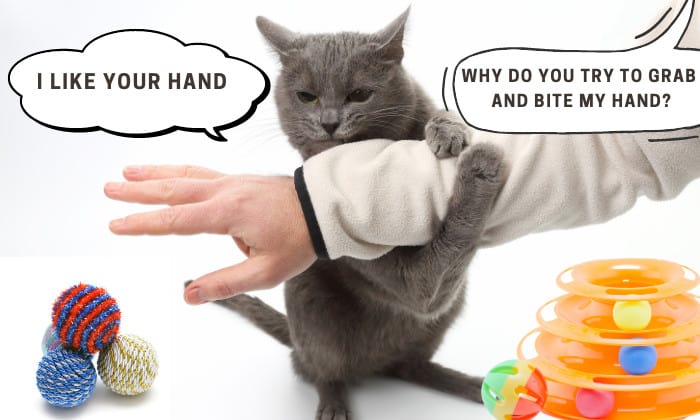
When it comes to our feline friends, their biting behavior can sometimes leave us puzzled. It’s important to understand the difference between playful biting and aggressive biting to ensure the well-being of both you and your cat. Here are some key indicators to help you recognize the distinction:
1. Body Language
Observing your cat’s body language is crucial in determining whether the biting is playful or aggressive. During play, cats often have relaxed body posture, with their tails held high and ears forward. On the other hand, aggressive biting is often accompanied by a tense body, flattened ears, and a swishing tail.
2. Bite Pressure
Another factor to consider is the intensity of the bite. Playful biting tends to be gentle, with minimal pressure applied. It may feel more like a nibble or a light touch rather than an actual bite. Conversely, aggressive biting involves stronger pressure, and it may break the skin or cause pain.
3. Playful Signals
Cats often use specific signals to communicate their intentions. Playful biting is usually accompanied by other playful behaviors, such as rolling on the ground, pouncing, and chasing. They may also engage in play-fighting with their paws without causing harm. Aggressive biting, however, lacks these playful signals and is often initiated without any warning signs.
4. Context and Duration
Understanding the context and duration of the biting incidents can provide further insight. Playful biting is typically short-lived and occurs during interactive play sessions. It may be triggered by a sudden movement or excitement. Aggressive biting, on the other hand, tends to be prolonged and may happen during moments of fear, stress, or territoriality.
5. Communication
Cats communicate through vocalizations, and this can also offer clues about their intent. During play, cats often emit soft chirps, trills, or purrs, indicating their enjoyment. Aggressive biting, however, may be accompanied by hissing, growling, or intense yowling sounds.
Remember, every cat is unique, and their behavior can vary. If you’re unsure whether your cat’s biting is playful or aggressive, it’s always best to consult with a veterinarian or a professional cat behaviorist. They can provide personalized advice based on your cat’s specific circumstances.
V. Tips for Preventing Hand Biting Behavior in Cats
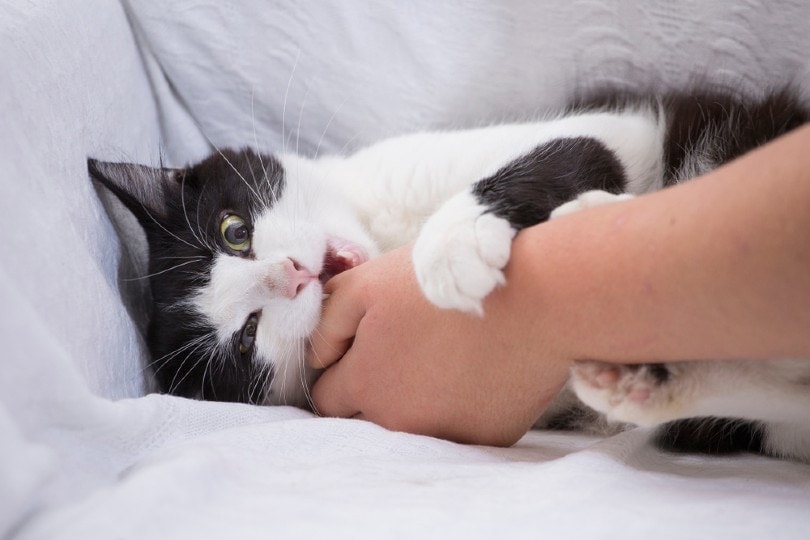
Dealing with hand biting behavior in cats can be frustrating and painful. However, with the right approach and some patience, you can prevent this behavior and foster a more harmonious relationship with your furry friend. Here are some tips to help you prevent hand biting behavior in cats:
1. Provide Appropriate Toys and Playtime
Cats need an outlet for their natural hunting instincts, so provide them with plenty of toys they can bite and scratch. Interactive toys, such as feather wands and laser pointers, can help redirect their biting behavior towards more appropriate objects. Additionally, regular playtime can tire them out and reduce their urge to bite hands.
2. Use Positive Reinforcement
Positive reinforcement is a highly effective way to train cats. Whenever your cat refrains from biting your hand, reward them with treats, praise, or a gentle petting session. This will help them associate good behavior with positive outcomes and encourage them to repeat it.
3. Avoid Rough Play
Although it may seem fun to engage in rough play with your cat, such as wrestling or play-fighting, it can reinforce hand biting behavior. Cats may not always distinguish between playtime and real aggression. Stick to gentle play and avoid using your hands as toys to prevent them from associating your hands with biting.
4. Redirect Their Attention
If your cat starts to bite your hand, quickly and calmly redirect their attention to a toy or another activity. This will help them understand that biting hands is not acceptable behavior. You can also try distracting them with treats or engaging them in interactive play to redirect their energy.
5. Provide Regular Nail Trims
Sharp nails can accidentally cause painful bites, so make sure to keep your cat’s nails trimmed. Regular nail trims will minimize the damage in case they do bite your hand and also reduce the likelihood of accidental scratches during playtime.
6. Seek Professional Help if Necessary
If your cat’s hand biting behavior persists or becomes aggressive, it’s important to consult a veterinarian or a professional animal behaviorist. They can assess the underlying causes of the behavior and provide you with tailored advice and training techniques to address the issue.
By following these tips and being consistent in your approach, you can effectively prevent hand biting behavior in your cat. Remember to be patient and understanding, as it may take time for your cat to unlearn this habit and replace it with more appropriate behaviors.
VI. Frequently Asked Questions about Cats’ Hand Biting Behavior
Here are some commonly asked questions about why cats grab your hand and bite you:
1. Why does my cat bite my hand when I pet her?
Hand biting behavior is often seen as a sign of overstimulation in cats. The petting might be enjoyable at first, but as their arousal level increases, they may react by biting.
2. Is hand biting a form of aggression in cats?
Hand biting can be a form of aggression, but it is important to examine the context. Sometimes, cats bite as a way of setting boundaries or communicating discomfort. Understanding the body language and triggers can help manage this behavior.
3. How can I prevent my cat from biting my hand?
One way to prevent hand biting is to pay attention to your cat’s body language. If you notice signs of restlessness or agitation, it’s best to stop petting and give them space. Providing appropriate toys and playtime can also help redirect their biting behavior.
4. Are there any medical reasons for hand biting behavior in cats?
In some cases, medical issues such as dental problems or pain can contribute to hand biting behavior in cats. If you notice a sudden change in your cat’s behavior, it’s advisable to consult a veterinarian to rule out any underlying health issues.
5. Can hand biting be a sign of fear or anxiety in cats?
Yes, hand biting can be a manifestation of fear or anxiety in cats. They may resort to biting as a defensive mechanism when they feel threatened or stressed. Creating a calm and secure environment for your cat can help alleviate their anxiety.
6. How should I react when my cat bites my hand?
It’s important not to punish your cat for biting, as this may escalate the situation. Instead, withdraw your hand calmly and redirect their attention to appropriate toys or scratching posts. Consistently reinforcing positive behaviors will help teach them acceptable alternatives to biting.
7. Can hand biting be a result of insufficient play or exercise?
Yes, cats may resort to hand biting if they are not adequately stimulated or exercised. Providing regular play sessions and interactive toys can help channel their energy and prevent them from engaging in unwanted biting behavior.
8. Should I seek professional help if my cat’s hand biting behavior persists?
If your cat’s hand biting behavior becomes a persistent issue or escalates in severity, it’s advisable to seek professional help from a veterinarian or a certified animal behaviorist. They can assess the situation and provide tailored advice to address the underlying causes.
Remember, each cat is unique, and understanding their individual needs and behaviors is essential in building a harmonious relationship with them.
I. Introduction to Cat Behavior
Understanding cat behavior is essential for any cat owner. Cats are unique creatures with their own set of instincts and behaviors. By gaining insight into why they behave the way they do, we can create a harmonious environment for both ourselves and our feline companions.
1. The Natural Instincts of Cats
Cats are born with certain natural instincts that greatly influence their behavior. One such instinct is hunting. Cats have an innate desire to stalk and pounce on prey, which is why they may exhibit behaviors such as chasing after moving objects or pouncing on your hand.
Another instinct that cats possess is territoriality. Cats are highly territorial animals, and they mark their territory by rubbing against objects or scratching on surfaces. This behavior is essential for them to create a sense of familiarity and security within their environment.
2. Communication through Body Language
Cats primarily communicate through body language, and understanding their signals can help prevent miscommunications and potential conflicts. For example, a cat’s tail position can indicate its mood or intentions. A relaxed, upright tail signifies a content cat, while a puffed-up tail indicates fear or aggression.
Similarly, a cat’s ears can provide valuable insights into their emotions. Ears that are held forward show interest and attentiveness, while flattened ears suggest fear or discomfort.
3. Playful Behavior and Socialization
Playing is an integral part of a cat’s life. It not only provides mental stimulation but also helps them develop their hunting and chasing skills. By engaging in interactive play with your cat, you can strengthen the bond between you and provide an outlet for their energy.
Socialization is also crucial for cats. Early exposure to various environments, people, and other animals can help them become more confident and adaptable in different situations. Proper socialization can reduce the likelihood of behavioral issues in the future.
4. Understanding Aggression and Biting
Occasionally, cats may exhibit aggressive behavior, such as biting. Understanding the underlying reasons behind this behavior is essential. Biting can be a defensive reaction, a sign of fear or pain, or even a way for cats to assert dominance.
It’s important to observe your cat’s body language and context to determine the cause of their aggression. Seeking professional advice from a veterinarian or animal behaviorist can help address and manage any aggressive tendencies in your cat.
By familiarizing yourself with the basics of cat behavior, you can forge a stronger bond with your feline companion and create a harmonious living environment. Remember, each cat is unique, and it’s important to observe and understand their individual needs and behaviors.
II. Understanding Your Cat’s Natural Instincts
When it comes to understanding why your cat grabs your hand and bites you, it’s important to take a closer look at their natural instincts. Cats, as independent predators, have certain behaviors ingrained in their DNA that can sometimes lead to playful but rough interactions with humans.
The Hunting Instinct
Cats are natural hunters, and their instinct to pounce, grab, and bite is a result of this innate behavior. In the wild, cats rely on these skills to catch prey and survive. When you play with your cat using your hand, they may see it as an opportunity to engage their hunting instincts.
The Prey Response
Your cat’s prey response is triggered by movement. When you wiggle your fingers or move your hand, it mimics the movements of prey, triggering your cat’s predatory instincts. This can lead them to grab your hand and bite as they would with their prey in the wild.
Communication and Defense
Cats also use biting as a form of communication and defense. When your cat grabs your hand and bites during play, it might be their way of expressing excitement or asserting dominance. It’s important to establish boundaries and teach your cat appropriate play behavior to minimize the risk of injury.
Redirecting the Behavior
If your cat tends to grab your hand and bite during playtime, it’s essential to redirect their behavior to more appropriate toys. Provide your cat with interactive toys, such as feather wands or puzzle feeders, that allow them to engage their hunting instincts in a safe and controlled manner.
Training and Patience
Training your cat to exhibit gentler play behavior requires patience and consistency. Use positive reinforcement techniques, such as rewarding your cat with treats or praise when they exhibit appropriate play behavior. Avoid punishing or scolding your cat, as this can lead to fear or aggression.
III. Reasons Why Your Cat Grabs Your Hand and Bites You
Having a cat as a pet can bring so much joy and companionship to your life. However, there may be times when your furry friend grabs your hand and gives you a playful nibble that can be quite painful. Understanding why cats engage in this behavior is important to maintain a harmonious relationship. Here are some reasons why your cat may grab your hand and bite you:
1. Playfulness and hunting instincts
Cats are natural hunters, and their instinct to play and pounce on moving objects is strong. When your cat sees your hand moving, it may trigger their hunting instincts, leading them to grab and bite your hand. It’s their way of engaging in play and exercising their predatory skills.
2. Overstimulation
Cats, like humans, have their limits when it comes to receiving physical affection. Petting your cat for an extended period or in certain areas may overstimulate them, causing them to grab your hand and give you a gentle nip. This behavior is their way of setting boundaries and letting you know they’ve had enough.
3. Redirected aggression
Redirected aggression occurs when a cat becomes frustrated or agitated by something they can’t reach or interact with, such as a bird outside the window. In their heightened state of arousal, they may redirect their aggression towards the nearest target, which could be your hand. This behavior is not personal; it’s simply a release of pent-up energy.
4. Teething or dental issues
Just like human babies, kittens go through a teething phase where their baby teeth fall out and are replaced by permanent teeth. During this time, they may have discomfort or itchiness in their gums, leading them to bite and chew on objects, including your hand. If your adult cat suddenly starts biting your hand, it could indicate dental pain or other oral health issues that require veterinary attention.
Cats that haven’t been properly socialized or trained may exhibit more aggressive behavior, including biting. If a cat hasn’t had positive interactions with humans or hasn’t learned appropriate play behavior, they may resort to biting as a defensive or attention-seeking tactic. Working with a professional trainer or behaviorist can help address these issues and improve your cat’s behavior.
Remember, each cat is unique, and the reasons for their biting behavior may vary. By observing their body language, providing appropriate outlets for play, and seeking professional guidance if needed, you can foster a loving and bite-free relationship with your feline companion.
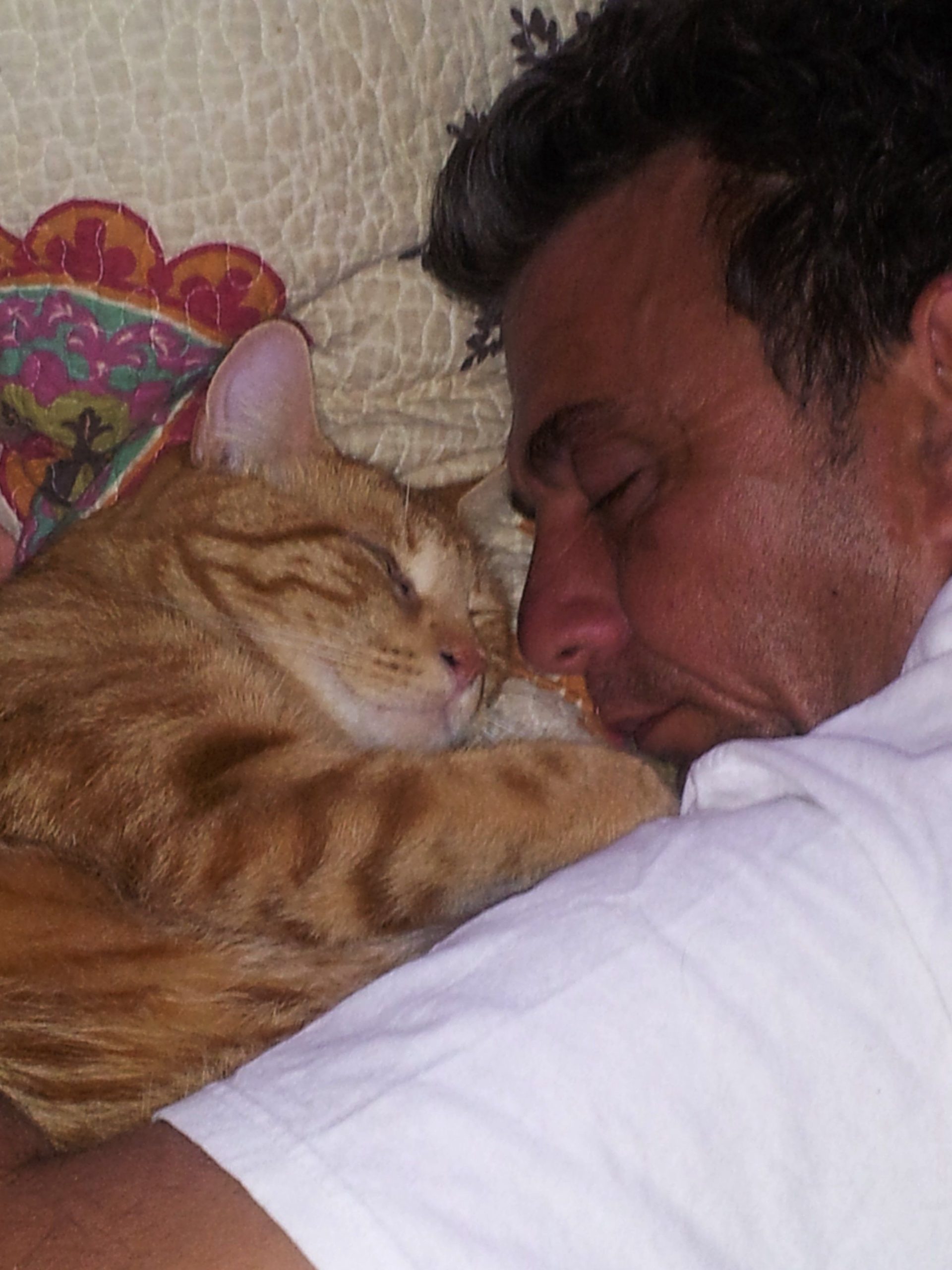
Jackson is an accomplished content writer with a flair for captivating storytelling. With a Bachelor’s degree in English Literature from the prestigious University of California, Berkeley, Hunter’s educational background has honed his writing skills to perfection. His love for felines is evident in his extensive knowledge of cat behavior and care, making him an expert in the field. Hunter’s passion for cats has led him to contribute insightful articles to various online platforms, providing valuable information and tips to cat owners worldwide. With his exceptional writing abilities and deep understanding of cats, Hunter continues to create engaging content that resonates with readers and leaves a lasting impact.
